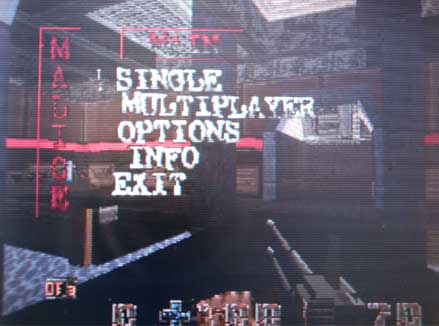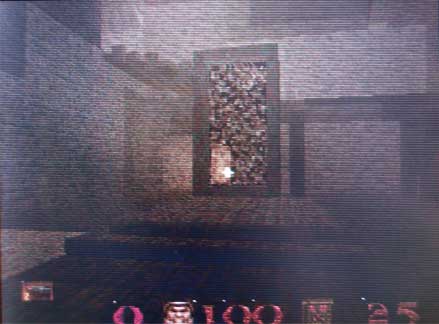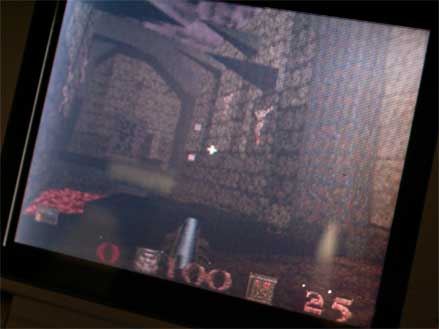
Quake is a registered trademark of id Software
Nintendo DS is a registered trademark of Nintendo
Introduction
| This is the home of the homebrew
port of Quake - the hit first-person shooter from 1996 - to the
Nintendo DS handheld system. Due to the limitations of the system, this port has taken a whole lot longer than it should have! Here's why:
|
 |
Current Status, as of 29/04/07
This port was started in mid-October 2006. It is not yet finished, however it is nearing completion.The game
|

|
Downloads
Prerelease 2
| quakeds_290407_pre2.zip |
This is the binary for the
second prerelease of QuakeDS |
| This is the binary for the build
which supports infrastructure-mode networking (coming soon) |
|
| This is the binary for the build
which uses the built-in memory found on some flash cards |
|
| quakeds_source_290407_pre2.zip |
Source for the second prerelease of QuakeDS |
| config.cfg |
The config file that I use to
run the game with. A regular PC one will do, but I know that this one
works :-) |
| DOS
shareware version |
Shareware version of the DOS
version of Quake - contains shareware pak files needed to run QuakeDS |
| Quake source | id's page of game source |
| DLDI for libfat |
Chishm's flash card driver page
- you need the appropriate file from this page in order to make QuakeDS
run |
How to play
This mini-guide assumes that you are familar with the process of running homebrew on your Nintendo DS. If you don't know how to run NDS homebrew, look online for the answer...- You need Quake's data files. If you own a copy, that's cool -
you'll have full access to the game. If not, then you can download the
shareware version of Quake (for DOS) from id's site. This will only
allow you to play the levels from the first episode. If you want to
play the full game, buy a copy - don't ask me (or others) where you can
get these files.
- In the root of your flash card, make a directory named id1
- If you're using the shareware version, copy pak0.pak from that archive into the id1 directory that you just created
- If you're using a commerical version, copy pak0.pak AND pak1.pak into that directory
- You need a config file to tell the game how buttons are set up, etc. I know that my config file works, so download that from the link above and save it into the id1 directory.
- Visit Chishm's DLDI page (above) and download the DLDI driver file which corresponds to your NDS booting method.
- Download the QuakeDS binary package above, and extract the NDS file into the root of your flash card
- You now need to patch that program so that it will be able to access the files on your card
- For example, on my GBA Movie Player (CF) I download the file named 'mpcf.dldi' from Chishm's page.
- I then run 'dlditool mpcf.dldi k:\QuakeDS.nds' - note K: is the
volume where my Compact Flash card is mounted, yours will likely differ
- Now do what you've gotta do to make an NDS start on your card
- For example, on my GBA Movie Player, I need to rename K:\QuakeDS.nds to K:\_boot_mp.nds
- Put the card in your booting hardware and turn on your DS!
Options
The game includes full control customisation, accessible from the usual place in the menu. However, the default settings provided from the Quake pak files aren't too enjoyable when using them on the DS, so feel free to use my config file.Don't forget that after making changes to the settings, you must use the 'SAVE SETTINGS' option to actually save your settings to disk. Quake would normally do this when you quit, but you don't really use the quit option on the DS! I may put in an auto-save option...
Current controls:
- touching the screen changes the camera view - sensitivity and
mouse invert can be chosen from the config menu too
- using the D-pad emulates the WSAD control method, so use up and down to move forward and backward, left and right to strafe left and right
- START is bound to escape, so this will bring up/hide the menu
- SELECT is bound to enter, so can be used to select entries in the menu...and also jump
- X/Y are weapon cycle up/down
- L is fire
- R is jump
- switch screens - for if you'd like to have the 3D view on the bottom screen
- antialias - turns line antialiasing on and off - not too noticable...
- wireframe overlay - for if you'd like to see brush models drawn with a wireframe overlay
- fog - this turns fogging on and off; there is a light fog when above ground, a thick fog when below water
- ds_screen_clears (0/1) - if you're trying to get some mod/total conversion to work and you'd like to see the warning/error messages, but they're cleared too quickly, set this cvar to zero
- ds_fog_red/green/blue (0..255) - this will change the fogging colour
- ds_alias_imposter (0/1) - if zero, then the model will only be rendered once its texture has been loaded (models may disappear for a second when gibbed); if one, a white texture will be shown on the model whilst the correct texture is loading
- ds_brush_imposter (0/1) - if zero, brush models (eg the world, health packs) will only be drawn once the texture has loaded, else it will be drawn a shade of grey
- ds_draw_imposter (0/1) - if zero, gui elements (eg ammo counts, the menus) will only be drawn once the texture has loaded, else it will be drawn white
- ds_turb_transparency (0..31) - this is used to make 'turb' brush
models
transparent - you should only use this with VIS'ed maps, or with the
r_novis hack (not recommended). Disable the effect by setting this to
31.
Using mods and total conversions
QuakeDS supports mods and total conversions. However, due to the low amount of free memory available on a stock DS, many of them cannot be run. Remember, QuakeDS has a ~3 megabyte game heap - many TCs (eg Malice) require a 16 meg heap. Be realistic when you're trying to get something to run. However, if you're convinced something should run but it just won't, get in contact with me and I'll try and help you get it running.To fully support these TCs, QuakeDS will use the extra memory provided by some flash cards (eg the Supercard, M3, Opera memory expansion) - a build support this will be available within a few weeks. In the meanwhile, you're gonna have to make do with the 3 meg heap!
To use mods/TCs, you need access to the Quake command line. The command line for QuakeDS is available in a file in the root of your flash card named 'qdsopts.txt'. To handle spaces in filenames etc, each option (of argv) must be separated by a newline character (both UNIX and MS-DOS newlines are supported).
So for example, to start the Malice TC with no sound, and no networking, qdsopts.txt would look like this:
-game<newline>
malice<newline>
-nosound<newline>
-notcp<newline>
<end of file>
not like:
-game malice -nosound -notcp<newline>If you make a mistake and it won't start you'll be able to see the processed command line options printed to the subscreen as the game starts.
Networking
QuakeDS supports infrastructure-mode wifi networking for UDP/IP PC-DS, DS-DS, etc-DS gaming. This means that you need an access point to play.There is currently no support for ad-hoc DS-DS gaming.
As the DS networking code takes up a large amount of memory, be aware that you are unlikely to be able to play all standard Quake levels in a co-op match. Wait for the combined EXRAM and networking build to play everything smoothly. Also, the server code in QuakeDS is (still!) unoptimised and this will slow down the other client. So if you can, put the server on a computer which has oodles of processing time :-)
To set up wifi play, you need to configure an access point. To do this, fire up a copy of Mario Kart and configure an AP in the first settings slot. You'll have more luck if you manually set IP addresses, rather than let DHCP do it for you. Once you have done this (and have checked that the settings work), fire up the networking build of QDS (will be available in a few days, after further testing). Go to the multiplayer menu and select join game. Then go to 'SEARCH FOR LOCAL GAMES' and choose the relavent server! Note that this requires the server to be on the same subnet as you, and UDP broadcast packets need to be supported by your network. If you'd like to manually enter an IP address, use the OSK to enter the address.
Transparent water
Quake does not natively support transparent stuff due to the way the maps are built. However there have been patches to Quake to allow you to get transparent water (and sludge, teleporters, lava etc) over the years, and I've added support for this to QuakeDS.Read here if you want details of the regular Quake way, as most of the details apply. http://retroquake.planetquake.gamespy.com/blog/?p=34
To summarise, there seem to be two ways to do it:
- You can use the r_novis variable: set it to one, rather than the default zero. This will disable all visibility checking in the renderer, and everything will be rendered - this will probably cripple the perofmrnace of your DS and you'll most likely get graphical errors as it greatly exceeds the DS' per-frame polygon limit. This is the easiest way, but is not recommended.
- The second way is to reVIS or get VIS'ed maps (or their patches). You can either do this yourself or get patches to adjust your pak files. I haven't tested this yet, but it ought to 'just work'! This is definately the recommended way to do it.
Legal
I take no credit for the development of Quake, that all goes to the guys at id Software. I also claim no copyright, trademark etc. Again, all work, copyrights, trademarks are owned by them.I have had no involvement with Nintendo (or their first-party or third-party companies), and I have not used any of their tools, software, documentation or SDK to make this port.
All I've developed is a small patch to make this game run on the Nintendo DS, and I have done so as a (non-profit) hobby over the last few months.
This is absolutely no warranty for QuakeDS, and neither I, the copyright holder, nor Drunken Coders will be liable to you for damages out of the use or inability to use the program.
That said, I know of no code within this program which is able to damage your DS or prevent it from booting!
The EXRAM build of QuakeDS uses Lick's RAM unlocking library. Ta mate!

